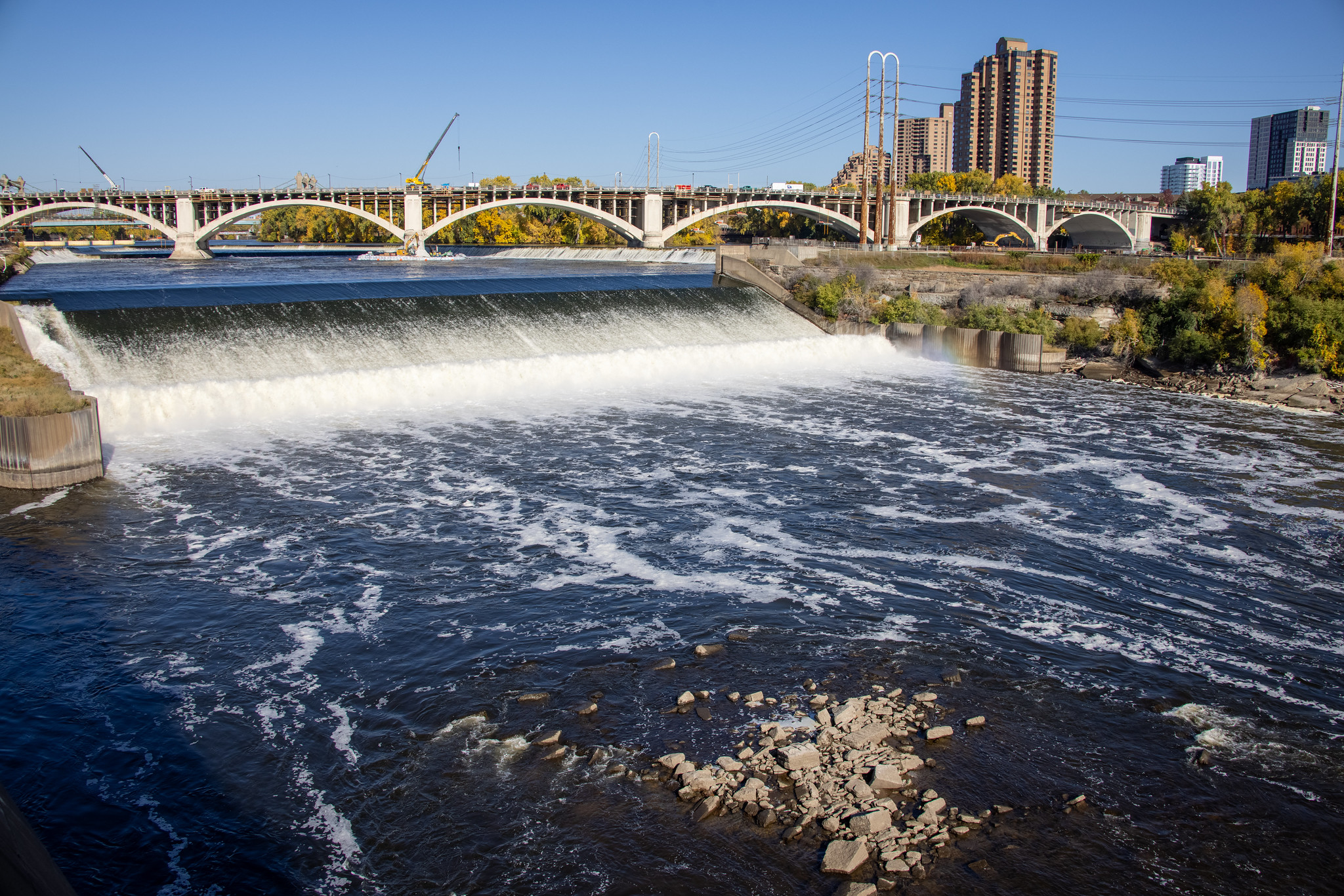The cutoff wall: St. Anthony Falls' hidden hazard

Many of us have seen St. Anthony Falls, but few know about the important underground cutoff wall sitting just upstream of it. The wall is between the main falls and the Third Avenue bridge. (Photo by Tom Reiter)
When the Army Corps of Engineers built an underwater concrete wall just upstream of St. Anthony Falls, the structure had one primary purpose: Hold up the falls to prevent another collapse of the riverbed, a potentially catastrophic outcome for the city.
That was in the 1870s. The cutoff wall is still in place today, supporting the iconic falls and safeguarding vital water levels.
Worryingly, nobody knows what condition the wall is in. We’re not sure when it was last maintained or even inspected. And it’s unclear who or what agency is responsible for ensuring it’s not on the verge of failure. Fortunately, a study of the wall is now underway.
The history of the cutoff wall
The cutoff wall is the result of a failed attempt to tunnel through the Mississippi River’s fragile bottom. It was in the fall of 1869, a year into the project, that this in-progress tunnel collapsed, creating a swirling whirlpool in the middle of downtown Minneapolis.
This prompted the U.S. Army Corps of Engineers to step in and stabilize the riverbed.
Many of us have seen the concrete apron that St. Anthony Falls now runs over, which was designed to prevent further erosion and collapse of the riverbed.
What isn’t visible is the cutoff wall located just upstream, which starts at the river bottom and plunges 40 feet underground. Built with concrete, the structure is 1,850 feet long and as much as 6 feet thick.
If this cutoff wall did not exist, the river's rushing water would erode the last few remaining feet of the limestone river bottom there — causing the falls to once again collapse.
What would happen if the falls collapsed?
The consequences of a cutoff wall failure and falls collapse would be dramatic.
Upstream water levels could drop too low to supply crucial drinking water supply intakes that serve Minneapolis, St. Paul and several suburbs. The water supply for 1 million Twin Cities residents, hospitals, schools and even fire hydrants could dry up within a few days.
The river bottom's collapse would also threaten roads and bridges, including the Third Avenue bridge, which sits just upstream of the falls near the edge of the limestone layer. Should the structures holding up the falls fail, the collapsing falls would erode away these last feet of limestone.
The cutoff wall underneath St. Anthony Falls is a critical piece of infrastructure. You wouldn't know it by how the wall is inspected and maintained.
That’s because it's not inspected and maintained. At all.
A wall without an owner
No one knows who owns the cutoff wall. No party, including the Army Corps (which constructed it in 1876), will take responsibility. It's also not clear when in the wall’s nearly 150-year history it was last inspected or maintained, despite signs this type of work might be needed.
Within a year of initial construction, the river began breaching small portions of the cutoff wall. This may still be occurring today. Many geologists who have reviewed the area's geology and history have told us that it's very possible — perhaps even likely — that the river’s water is currently carving its way over, under, and through the cutoff wall, destabilizing the structure.
Climate change only increases the risk. An extreme flood event could put unique pressure on river infrastructure and increase the odds of failure.
A long-overdue study is underway
FMR and our partners have been raising the alarm about this problem since it was uncovered. That includes board member John Anfinson, who has led this work and conducted many hours of research and outreach in an attempt to untangle the issue.
So far, no party or government agency accepts responsibility for owning or maintaining the wall, though many agree with us that continuing to ignore it could be dangerous.
In 2023, FMR asked the Minnesota Legislature to fund a study of the wall. Thanks to the leadership of senators Bobby Joe Champion and Erin Murphy, and representatives Ginny Klevorn and Sydney Jordan, the state has provided $1 million in funding for this important project.
The University of Minnesota's St. Anthony Falls Lab and Hennepin County will be leading this study of the wall's condition, the surrounding geology and hydrology, and what the public safety and infrastructure impacts could be should St. Anthony Falls collapse. An onsite geotechnical examination of the wall and its surroundings will be completed in 2024, with the full project closing out in mid-2025.
This is an important step in building momentum and urgency for resolving the wall's ownership questions and ushering in any required maintenance and ongoing monitoring. We still need our federal and state government partners to lead in determining who owns and is ultimately responsible for the wall.
Want more information?
The Star Tribune has written a clear, thorough overview of the cutoff wall problem, complete with diagrams and extensive interviews with John Anfinson and others. MinnPost has covered this issue in detail as well.
If you're curious to learn more about the cutoff wall, we highly recommend diving into this article and checking out the TPT Almanac interview with reporter Eric Roper.
Become a River Guardian
Sign up and we'll email you when important river issues arise. We make it quick and easy to contact decision-makers. River Guardians are also invited to special social hours and other events about legislative and metro river corridor issues.